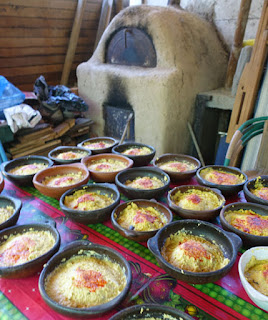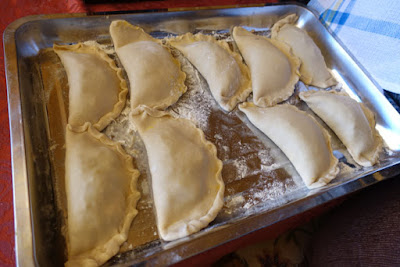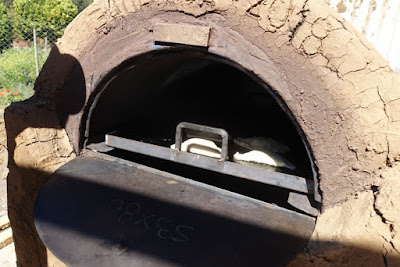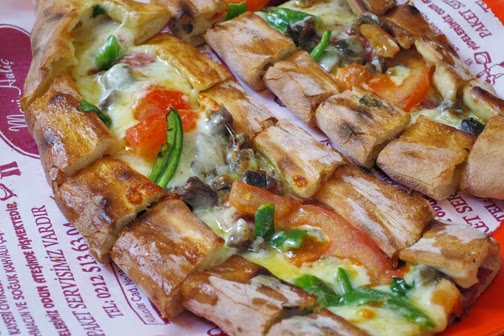52 Places to Go: Week 45
 |
| Dubrovnik, Croatia |
My friend and fellow children’s writer Caroline Hatton visited Croatia
in May of 2012 and has graciously written this article about her trip. You
can find out more about Caroline and her books and at her website, www.carolinehattonauthor.com . She
took all the photos in this post.
 |
| BREAKFAST |
At
the first hotel where my husband and I stayed, the room price included a hearty
breakfast. We
had omelets cooked to order, skipped the ham and salami, and admired the
mystery packets of what looked like vanilla or chocolate pudding, liverwurst,
cream cheese, jam, and butter. While exploring Croatia with a couple of
American friends for two weeks, room prices included similar breakfasts, except
for rooms rented out by private citizens.
For
lunch, we shared a sampler of typical Croatian food, i.e., meat:
 |
| MEATLOVERS LUNCH |
The
finger-sized sausages were the famous, delicious, vigorously seasoned ćevapčići. The spiral sausage was
the chef’s specialty. The meat chunks were chicken, pork, and beef, the
standard components of the ubiquitous “mixed grill” menu item. The beans, we
never saw anywhere else, a noteworthy fact for vegetarians. The red delicacy was
ajvar (a red bell pepper and garlic relish
that most Croatians are crazy about).
Fortunately
for our waistlines, we walked for hours through the old Zagreb, up and down
medieval stone stairs and streets. By dinner time, we could fathom trying
another meat dish:
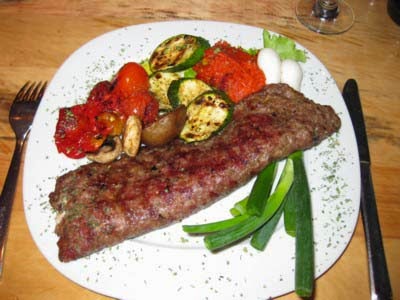 |
| CHEESE STUFFED GROUND MEAT |
This
was punjena pljeskavica (cheese
stuffed ground meat, enthusiastically seasoned). The grilled vegetables were
available as a separate item on most menus, and often included carrot, eggplant,
bell pepper, onion... whatever looked good at the market.
 |
| SIBENIK WALLET |
Stuffed
pork came in different varieties. The above “Šibenik wallets” were stuffed
with prosciutto and cheese, and named after their hometown. There, the medieval
pedestrian center was a captivating place to walk off calories.
Fish
and seafood were widely available, often with a side
of mangold (Swiss chard) and potatoes,
as seen in this sea bass entrée:
 |
| SWISS CHARD POTATO SIDE |
Below:
a mussel; the closed and open pair was kunjka (Noah’s Ark shellfish) found only in the Adriatic and Mediterranean;
and the clam was brbavica or šarga
(warty venus).
 |
| SHELLFISH |
For
picnics on long mountain hikes, we loved to buy bùrek (filo pastry stuffed
with cheese, spinach, or ground meat) from bakery shops. Lightly sweetened
varieties contained a smear of fruit mush:
 |
| BUREK SWEET |
We
saw many garden-shed-size roasters outside of food shops, for whole pigs, but we
never saw any roast pork, perhaps more common in the high summer season.
For
vegetarians, commonly available proteins were eggs for breakfast and cheese any
time. Beans, we saw only once on our first lunch plate, in Zagreb.
My
second-most favorite meal in Croatia was in the medieval walled city of
Dubrovnik on the Adriatic. Stone-paved pedestrian streets were lined with
restaurant tables, leaving only a narrow lane for waiters and passers-by.
Octopus
salad was on my must-try list. We saw it on the menu for the first time on our
trip. We ordered it.
Before
letting our waiter, a man perhaps 18 years old, walk away, I asked him to take
a photo of my husband and me. As I handed him my point-and-shoot digital
camera, I said, “Press this button to turn it on.” He said, authoritatively, “I
know. I am young.”
Then
he brought the octopus salad:
 |
| OCTOPUS SALAD |
A
minute later, the restaurant owner, a man perhaps 50 years old, brought a
serving spoon and said, “Excuse my son. He is young.”
The
octopus was tender, delicate, and distinctive. The balance of tomato, lettuce,
and onion, and the small amount of vinaigrette and herbs, was perfect. This
gourmet dish was offered at Konoba Nava in Dubrovnik Old Town.
 |
| MLJET ISLAND |
My
favorite meal in Croatia was on the Adriatic island of Mljet http://www.mljettravel.com/, in the hamlet of Soline,
a row of about six contiguous stone houses. Between the one-lane road and the
shore of the salt water lake, Veliko Jezero, the locals had set up tables and
chairs on shaded patios. We were told that the lady “in that house” (I forget
if it was number 3 or 4) served dinner.
We
poked our heads in her open door, into a kitchen with a jolly group at a table.
The lady greeted us. We asked about dinner.
She bent down to pick up a plastic bucket, from which she lifted freshly
dead fish, one at a time—the day’s catch. There was only one of each kind, each
one a different mottled grey. The eel
wasn’t our friends’ idea of food. So we pointed at two other big fishes, which
the lady identified as škaram
(barracuda) and cipal (mullet).
She
brought local wine to the patio table. While we enjoyed the balmy evening, she
got busy chopping a little wood for her outdoor brick barbecue, getting a fire
going, preparing the fish, and grilling it to perfection. She also served a tomato
salad, boiled potatoes, bread, and homemade goat cheese, and put the customary
bottle of local olive oil on the table.
This
was my best meal in Croatia because the fish, friendship, and serene setting
were exquisite, and also because I love how the cook presented the menu choices!
Caroline is working
on a horse story set in Croatia at a location similar to Linden Tree Retreat
and Ranch http://www.lindenretreat.com/ where she went on an unforgettable horse
ride with owner and guide, Bozidar Bruce Yerkovich.
This article was originally published at The Intrepid Tourist 1/12/15.












